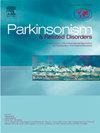注射用大西肉毒杆菌毒素ina治疗成人宫颈肌张力障碍的疗效和安全性:aspen1和aspen1 - cn随机试验的综合全球分析
IF 3.4
3区 医学
Q2 CLINICAL NEUROLOGY
引用次数: 0
摘要
背景:注射用大西肉毒杆菌毒素(DAXI)是第一个长效A型肉毒杆菌毒素(BoNT),被FDA批准用于治疗宫颈肌张力障碍(CD)。DAXI的新配方,包括定制工程肽,旨在提供延长的临床益处。目的:通过两个3期、多中心、随机、双盲、安慰剂对照试验,评估DAXI治疗CD的疗效和安全性:在北美和欧洲进行的aspen1试验,以及在中国进行的aspen1 - cn试验,aspen1 - cn是一项设计相似、规模较小的关键临床试验。方法:成人中重度CD患者随机(3:3:1)接受DAXI 125U、DAXI 250U或安慰剂治疗。主要终点是第4周和第6周多伦多西部痉挛性斜颈评定量表(TWSTRS)总分从基线的变化。一个关键的次要终点是持续时间,定义为直到峰值效应消失80%的时间。结果:共有357名受试者被随机分组,分别接受DAXI 125U (n = 149)、DAXI 250U (n = 154)和安慰剂(n = 54)治疗。与安慰剂相比,DAXI 125U(-12.0)和DAXI 250U(-11.9)显著提高了TWSTRS平均总分(-4.6);P结论:两项3期试验的合并分析表明,DAXI是一种有效、安全、长效的CD治疗药物。关键不良事件的发生率低于之前的BoNTs治疗CD的关键试验。本文章由计算机程序翻译,如有差异,请以英文原文为准。
Efficacy and safety of DaxibotulinumtoxinA for injection in adults with cervical dystonia: Pooled global analysis of ASPEN-1 and ASPEN-1-CN randomized trials
Background
DaxibotulinumtoxinA for injection (DAXI), the first long-acting botulinum toxin (BoNT) type A, is FDA approved for cervical dystonia (CD). DAXI's novel formulation, which includes a custom-engineered peptide, is designed to provide an extended duration of clinical benefit.
Objective
To evaluate the pooled efficacy and safety of DAXI for CD across two phase 3, multicenter, randomized, double-blind, placebo-controlled trials: ASPEN-1, conducted in North America and Europe, and ASPEN-1-CN, a similarly designed, smaller pivotal clinical trial, conducted in China.
Methods
Adults with moderate-to-severe CD were randomized (3:3:1) to receive DAXI 125U, DAXI 250U, or placebo. The primary endpoint was change from baseline in Toronto Western Spasmodic Torticollis Rating Scale (TWSTRS) total score averaged across weeks 4 and 6. A key secondary endpoint was duration, defined as time until loss of >80 % of peak effect.
Results
In all, 357 subjects were randomized and received DAXI 125U (n = 149), DAXI 250U (n = 154), or placebo (n = 54). DAXI 125U (−12.0) and DAXI 250U (−11.9) significantly improved the mean TWSTRS total score versus placebo (−4.6; P < 0.0001). Median (95 % CI) duration of effect was 24.1 (20.6–28.9) weeks for DAXI 125U and 22.0 (20.1–24.3) weeks for DAXI 250U. Rates of treatment-related dysphagia (125U: 4.7 %, 250U: 4.5 %) and muscle weakness (125U: 5.4 %, 250U: 4.5 %) were low for both active doses.
Conclusions
This pooled analysis of two phase 3 trials demonstrates that DAXI is an effective, safe, and long-acting treatment for CD. Key adverse events occurred at rates lower than prior pivotal trials of BoNTs for CD.
求助全文
通过发布文献求助,成功后即可免费获取论文全文。
去求助
来源期刊

Parkinsonism & related disorders
医学-临床神经学
CiteScore
6.20
自引率
4.90%
发文量
292
审稿时长
39 days
期刊介绍:
Parkinsonism & Related Disorders publishes the results of basic and clinical research contributing to the understanding, diagnosis and treatment of all neurodegenerative syndromes in which Parkinsonism, Essential Tremor or related movement disorders may be a feature. Regular features will include: Review Articles, Point of View articles, Full-length Articles, Short Communications, Case Reports and Letter to the Editor.
 求助内容:
求助内容: 应助结果提醒方式:
应助结果提醒方式:


